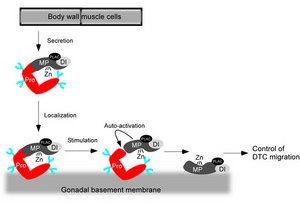Aug. 24, 2007 Research Highlight Biology
Enzymes lead the way
A protease enzyme called MIG-17 points cells in the right direction during the development of organ
 Figure 1: MIG-17 is secreted from muscle cells and relocates to the gonad, dependent on action of the prodomain (Pro). An unknown stimulus then causes cleavage of the molecule, leaving the metalloprotease (MP) domain exposed with an active zinc (Zn) ion that controls migration of the distal tip cells (DTCs) during growth of the gonad. © EMBO/European Molecular Biology Organization/26/2617 (2007)
Figure 1: MIG-17 is secreted from muscle cells and relocates to the gonad, dependent on action of the prodomain (Pro). An unknown stimulus then causes cleavage of the molecule, leaving the metalloprotease (MP) domain exposed with an active zinc (Zn) ion that controls migration of the distal tip cells (DTCs) during growth of the gonad. © EMBO/European Molecular Biology Organization/26/2617 (2007)
During the growth and development of organs, proteins act from outside the organs to direct the movements of cells. Researchers at the RIKEN Centre for Developmental Biology in Kobe have identified one such protein that is essential for the development of gonads in the nematode roundworm Caenorhabditis elegans1.
In C. elegans, the gonads grow along the body wall and then turn through 180°, making two U-shaped gonad arms. The movement is directed by two specialized leader cells called ‘distal tip cells’ (DTCs). The researchers found that when they inhibited the activity of a proteolytic enzyme called MIG-17, the DTCs failed to function properly, resulting in misshapen gonads.
”We mutagenized wild-type worms with [a] chemical mutagen and isolated many mutant worms with misshapen gonads,” says group leader Kiyoji Nishiwaki. “The MIG-17 mutant is one of these isolates and was found to encode a protein of the ADAMTS protease family.”
The MIG-17 enzyme is secreted from muscle cells, and is initially folded over to hide an active zinc ion (Fig. 1). The researchers discovered that actions in part of the MIG-17 molecule called the prodomain are essential for moving the molecule to the gonad. However, the prodomain must first be modified by another protein, MIG-23, in a process called glycosylation.
Previous studies had indicated a role for the prodomain in protein folding and secretion, but this is the first time it has been shown to be crucial for targeting the whole MIG-17 molecule to the gonad. “It is possible that prodomain targeting is one of the key strategies employed by ADAMTS proteins to localize to specific tissues,” says Nishiwaki.
Once the MIG-17 molecule reaches the gonadal membrane, an unknown stimulus initiates autocatalytic cleavage of the molecule. The prodomain falls off, leaving the active zinc ion exposed (Fig. 1). “The zinc ion probably degrades a specific substrate in the gonadal membrane and thereby acts in directing DTCs,” explains Nishiwaki.
In humans, mutations in ADAMTS proteins cause various hereditary diseases related to disorders in connective tissues. MIG-17 is most similar to an enzyme called ADAMTS-10 that may have a role in organ development in humans.
“ADAMTS-10 is a causative gene for Weill–Marchesani syndrome [in humans], characterized by short stature, shortness of fingers and toes and eye abnormalities,” says Nishiwaki. “Abnormalities of internal organs may also occur, although this is not examined yet.”
References
- 1. Ihara, S. & Nishiwaki, K. Prodomain-dependent tissue targeting of an ADAMTS protease controls cell migration in Caenorhabditis elegans. The EMBO Journal 26, 2607–2620 (2007). doi: 10.1038/sj.emboj.7601718
